Article body copy
One of the biggest mistakes novice children’s book writers make is to assume that a story must teach something. An overt message—share, don’t be a bully, eat your veggies—can make for a boring book. There can, of course, be a lot to learn in children’s books, but it takes a deft hand to avoid being didactic. Several of this season’s marine-themed books tackle big subjects—death, extinction, fear, even a lost toy (a monumental disaster for some). But in the hands of these skilled writers and illustrators, any takeaway messages are secondary to a good story well told. First and foremost, these creators offer rich language, characters and places to care about, and beguiling adventures. Along the way, they help us learn something, too.
Dive, Dive into the Night Sea
Text and illustrations by Thea Lu
32 pp. Candlewick Studio
Illuminated by the light of a full moon, a diver steps off a boat into water and invites the reader to “dive into the inky depths” and explore the ocean at night. Most young readers will have some familiarity with marine life, such as corals and tropical fish, portrayed in vivid, rainbow-colored hues, but the ocean at night is more monochrome. The palette in Dive, Dive into the Night Sea is subdued, primarily blue, black, and gray. Spots of light—from the moon, the diver’s flashlight, and even the organisms themselves—illuminate sea life. The text is spare and evocative and prompts the reader to think about the environment from the diver’s perspective: “If I’m brave enough to turn off my light, how will the night sea reward me?” Liftable flaps throughout the text offer more details on organisms encountered during the dive, giving information on the gooey nests of parrotfish, the filter-feeding behavior of manta rays, the daily migrations of zooplankton, and more. For children who might fear the dark, this book provides an alternative and evocative perspective—the dark is just another fascinating habitat to explore.
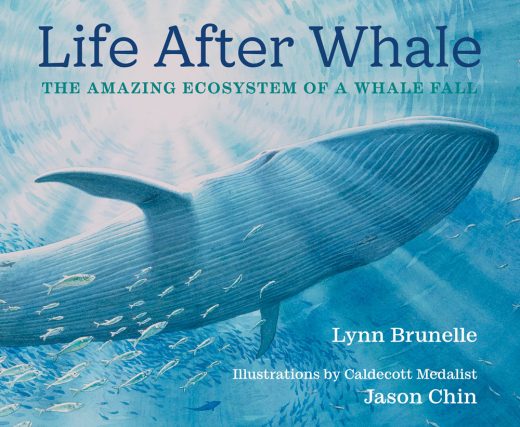 Life After Whale: The Amazing Ecosystem of a Whale Fall
Life After Whale: The Amazing Ecosystem of a Whale Fall
Text by Lynn Brunelle
Illustrations by Jason Chin
48 pp. Neal Porter Books
A majestic blue whale has lived for 90 years. Now, “something is different. Her heart is slowing down. It is wearing out.” Life After Whale is a stunningly crafted story that explores the full cycle of the world’s largest animal, focusing on the life that thrives on the whale’s body after death. Using clear but lyrical prose, the author evokes the beauty of the natural world and how with death comes new life. The whale’s death “is the end of one story, but the beginning of another,” the author writes. The text recounts all stages of death, starting with the whale’s bloated carcass on the surface of the ocean, but much of the text details the ecosystems that thrive when a whale falls to the ocean floor. Once there, the whale provides food for hundreds of creatures for years until it becomes a reef of bones. The story comes full circle as we learn how nutrients released back into the ocean from the whale’s decomposition fuel the growth of plankton, which in turn nourish a young, pregnant blue whale feeding at the ocean’s surface. Life After Whale is a fascinating book that is sure to capture the interest of curious readers. It also provides an avenue for discussing a more challenging topic: death.
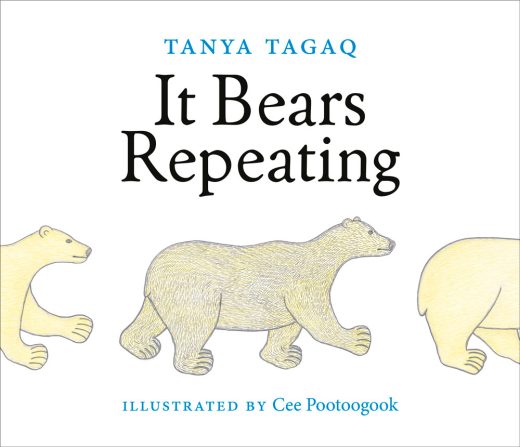 It Bears Repeating
It Bears Repeating
Text by Tanya Tagaq
Illustrations by Cee Pootoogook
24 pp. Tundra Books
It’s common for children to request their most beloved picture books on repeat. This counting book embraces this idea in its title—although the pun will be largely lost on its audience. With simple, spare text and illustrations, It Bears Repeating tracks a growing cadre of polar bears from one to 10. Both the author and illustrator are Inuit, as shown by the inclusion of an Inuktitut phrase on each page and the distinctive printmaker technique of Cape Dorset, Nunavut, where illustrator Cee Pootoogook resides. The first bear begins its day with a stretch: “Atausiq nanuq / One polar bear. / One proud bear. / Stretching up to sniff the air. / One tall, long bear.” With each spread, the bear is joined by another, and the bears slide, run, hunt, swim, dance, and snooze their way through their Arctic home. The book has great potential for story time when children are a bit antsy—they can stretch and wiggle right along with the bears. The publisher includes a translation and pronunciation guide for the Inuktitut words, as well as a link to the author, Tanya Tagaq, reading the book.
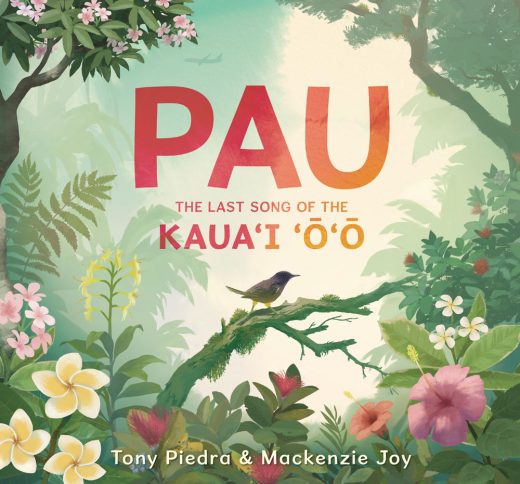 Pau: The Last Song of the Kaua‘i ‘Ō‘Ō
Pau: The Last Song of the Kaua‘i ‘Ō‘Ō
Text by Mackenzie Joy
Illustrations by Tony Piedra
40 pp. Candlewick Press
In Hawai‘i, the word pau means something that is lost forever. The song of the ‘ō‘ō once filled the island of Kaua‘i, but as more people came to the island with new plants and animals and cleared habitat, the songbird became increasingly rare. In 2021, it was declared extinct. Although the topic is a tough one, Pau: The Last Song of the Kaua‘i ‘Ō‘Ō depicts well the things that can drive extinction—introduced species, habitat loss, natural disasters—and how species loss is often the result of a series of unfortunate events piling up over time until it’s too late. End notes provide further details on the ‘ō‘ō’s extinction, including illustrations of species introduced by Polynesians and Europeans and a timeline showing how Kaua‘i changed since the first humans arrived more than 1,000 years ago. A QR code provides a way to hear the bird’s melodious song.
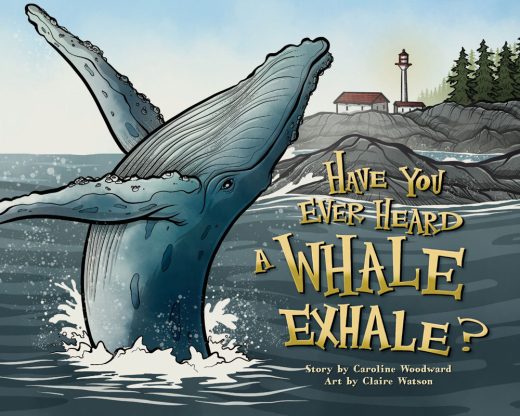 Have You Ever Heard a Whale Exhale?
Have You Ever Heard a Whale Exhale?
Text by Caroline Woodward
Illustrations by Claire Victoria Watson
32 pp. Pownal Street Press
Using the device of rhetorical questions—meant to inspire or spark imagination rather than illicit answers—each spread in Have You Ever Heard a Whale Exhale? peeks at the daily life of a marine creature. The author skillfully includes all the senses: young readers are asked if they’ve ever heard a seagull sweetly sing, smelled a sea lion herd, or tasted salty herring roe, for instance. The illustrations depict the morphology of marine creatures reasonably accurately, while infusing whimsy. There’s a seal with a monocle, a dancing octopus, an operatic gull, and a flock of cormorants fending off the stink of sea lions with clothespins on their bills. This is a fun rhyming read for young people, and the book provides lots of fodder for a discussion about the sensory ways in which we explore the world.
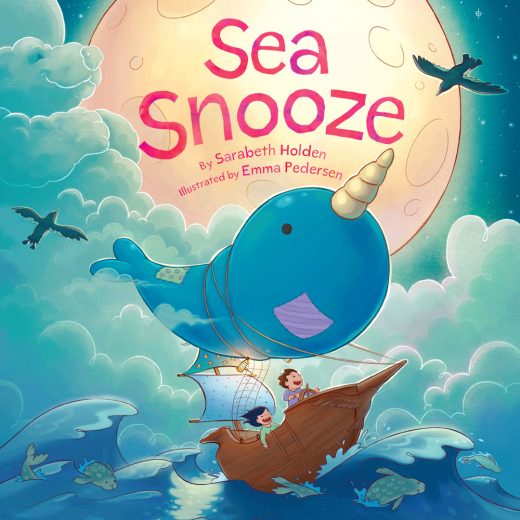 Sea Snooze
Sea Snooze
Text by Sarabeth Holden
Illustrations by Emma Pedersen
32 pp. Inhabit Media
Sea Snooze opens with a slightly chaotic bedtime scene relatable to many parents—two mischievous children are giggly and wide awake, and their bed is cluttered with stuffies, blankets, and a hockey stick. Mom, however, is calmly reading. She invites the children to get aboard their little boat, “We’ll sail all night. Let’s see where we float!” From there, we see the two children off on their own whimsical adventure, sailing their bed-cum-boat through the Arctic sea and sky: “Over the mountains and across icy seas, sailing we’ll go with the singing breeze.” They take a tumultuous, but seemingly fun, ride through the night, encountering clouds shaped like polar bears eating fish pie, belugas swimming alongside, and gulls flying by, calling “Atii!,” “let’s go” in Inuktitut. Things start to calm down as the sun rises: “The gulls, whales, and seals will wave goodbye as we go. From dreamland to daytime, we’ll see the sky glow.” The journey from energy to calm through this adventurous dreamscape is the perfect way to put young adventurers to sleep.
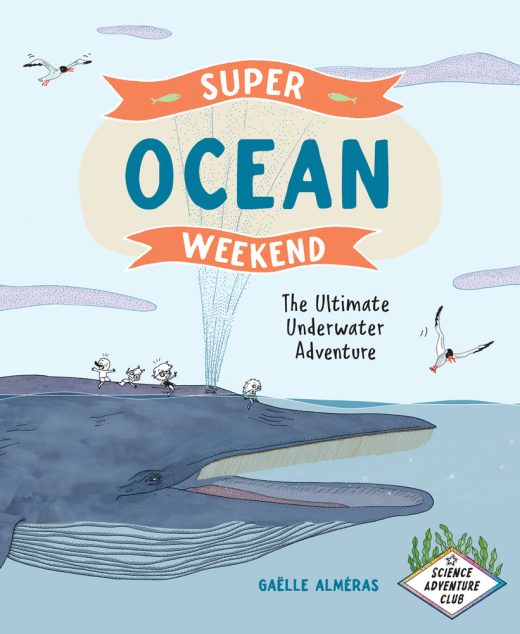 Super Ocean Weekend: The Ultimate Underwater Adventure
Super Ocean Weekend: The Ultimate Underwater Adventure
Text and illustrations by Gaëlle Alméras
172 pp. Greystone Books
In Super Ocean Weekend, nonfiction graphic novel meets encyclopedia of the ocean. As promised by the title, four friends—an echidna, a beaver, a rat, and a platypus—head off in their camper van for the weekend to explore the sea. They’re guided by Echid, the echidna, “who has lots to teach them about the ocean and the creatures that live there.” Through comic-style illustrations, the friends quickly get down to it, discussing everything from tides and buoyancy to biodiversity and bioluminescence. The book is comprehensive, yet not overwhelming, and the author-illustrator’s use of simple visuals with brief captions makes it a satisfying book, which can be read for the storyline or used as a reference book to dip in and out of. The four characters have different personalities, which are cleverly aligned with ocean-friendly activities at the end of the book.
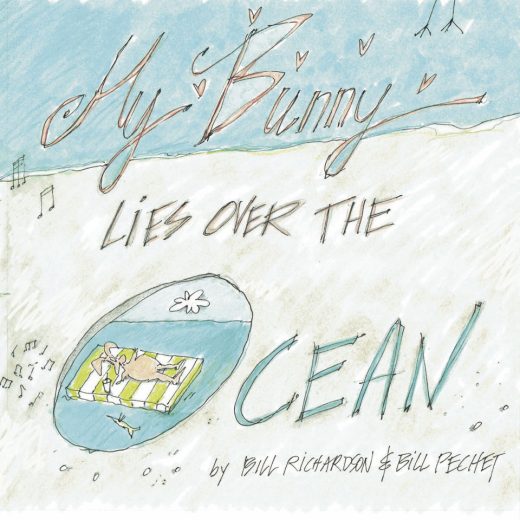 My Bunny Lies Over the Ocean
My Bunny Lies Over the Ocean
Text by Bill Richardson
Illustrations by Bill Pechet
36 pp. Running the Goat Books
The ability to gauge whether an experience is truly disastrous varies from person to person. Although most adults learn to put things in perspective, for a young child, losing a beloved stuffie can be catastrophic. So begins the romp My Bunny Lies Over the Ocean, set to the tune of “My Bonnie Lies Over the Ocean.” Bunny is left behind after a visit to the beach, and the text begins with a lament: “My Bunny was left at the seashore, my Bunny washed out with the tide, ‘Oh, help me, won’t somebody help me? I can’t swim,’ my poor Bunny cried.” From there, we watch Bunny make its way around the world and have a variety of silly experiences. It meets Starfish Rescue Inc., spends some time in a whale’s belly (from which Bunny is unceremoniously barfed out), and even takes a trip in a kangaroo’s pouch. This book has little factual information about the ocean to teach young readers, but it will put a smile on their faces. And yours.
This post was originally published on here







